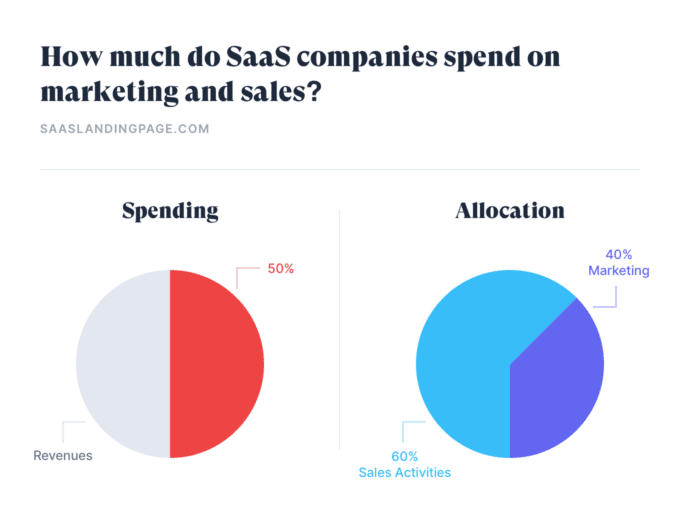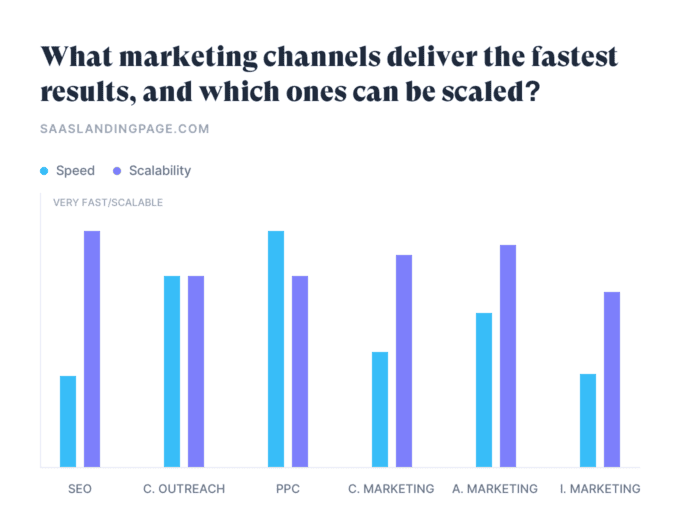Top Marketing Channels to Grow and Scale Your SaaS

Marketing is important for nearly any type of company — and for SaaS vendors and providers, it’s often crucial. In fact, according to McKinsey, high growth SaaS businesses often end up spending 50% or more of their revenue on sales and marketing. This makes sense given that it’s been said that the marketing efforts of SaaS companies contribute more than 50% to their success.

Many SaaS companies have found that one of the most effective approaches to growth is finding channels that are effective at providing a stream of new clients and leaning into those channels, optimizing sales and marketing approaches as needed.
Marketing channels refer to platforms, channels, or mediums that can be used to reach a target audience and used to promote your business. To better understand, in the context of SaaS marketing, let’s explore some of the channels that SaaS companies have embraced, and how they work.
These are SaaS marketing channels that have been found to be highly effective, when properly utilized, at driving growth, so a thorough understanding of them can be key to your approach to marketing. Let’s jump in and explore.
Top 6 Marketing Channels for SaaS
For SaaS companies, there are a ton of marketing channels to choose from. To help clarify our options, let’s explore some of the most common and effective channels.
1. SEO
SEO, or Search Engine Optimization, refers to the systematic process of taking steps to increase a domain’s visibility on popular search engines, such as Google or Bing. SEO is an important process for nearly any web-facing business, and SaaS vendors are certainly no exception.
SEO requires a multi-pronged approach, and involves not only optimizing the configuration and content of your website in many cases, but also an external approach that fosters inbound linking to your domain as well.
Internally, this involves properly utilizing meta-data on web pages for easier crawling and indexing, the inclusion of important key phrases related to common searches made by your target audience, and creating content that’s designed to support SEO practices.
Externally, it may involve establishing a parallel presence on other platforms, guest posting, and encouraging links back to your domain. Ultimately, the most important consideration in SEO might be that of creating useful content. Search engines often try to prioritize content that users find helpful.
Since SaaS can be such a competitive market, with myriad solutions available, SEO aims to help SaaS companies stand out in the search results.
2. Cold Outreach
Cold outreach is a process that involves contacting those with whom your business has no prior relationship. Cold outreach can include cold-calling, cold emails, and even cold messaging on platforms such as Linkedin.
While cold outreach differs from many traditional marketing practices in that it involves an audience that may be seen as harder to convert since they have no relationship with your company or product, it can nonetheless be an effective marketing channel for a few reasons. Chief among these is that it presents a much larger pool of potential clients to tap into, and it also represents a highly proactive and growth-oriented approach.
A common cold outreach approach in the SaaS industry is that of cold emails. There are some vital considerations to take when sending cold emails, however. Importantly, recipients of cold emails may or may not be interested in your services, so it will be your job to convince them that you’re offering a unique value proposition.
In order to do this, it may be helpful to clearly outline what you’re offering, take advantage of email marketing best practices (such as including actionable links above the fold and using a great email design), and work to personalize emails.
But how do you personalize emails to strangers? This is where cold emailing best practices come in. First, avoid buying lists of email addresses. Many prospects will have an email address publicly available to use. If you’re targeting your cold email campaign to specific organizations or industries, this may be where you start looking for email addresses to use.
Next, take advantage of the fact that you didn’t buy your email list, and use the information that you used to find the email addresses in the first place — such as their company website, any news they’ve been featured in or their social media presence. With this information, you can often begin a conversation that takes into account their pain points and needs — one that’s less likely to come across as generic and automatically generated.
3. PPC Advertising
PPC, or Pay-Per-Click advertising is almost exactly what it sounds like. This refers to online advertising through which you only pay for click-throughs. It’s become a dominant model in the online ad industry, and for many companies, including SaaS vendors and suppliers, it works.
Typically, PPC involves purchasing ad space on a platform such as a search engine, and from there you only pay for click-throughs. However, while PPC may seem like a fire-and-forget strategy since you’re only paying for clicks, it can be far from it. PPC can necessitate careful management if you hope to make it as effective as possible.
This might mean ensuring that the pages your PPC ads link to are optimized for fast loading time, running A/B testing to find campaigns that result in the highest conversions, and consistent optimization over time to hone your approach for success.
4. Content Marketing
Content marketing refers to the practice of generating and disseminating content (ideally that your target audience finds useful) that, in turn, can stand to drive more traffic to your website, and engage interested prospects. Content marketing takes many forms, including blogging, writing articles, posting video content, and even social media posting.
While it can be tempting to pack content with calls to action and promote your services, this approach isn’t always necessary or effective. Content marketing often works well when a brand simply offers valuable content and asks nothing in return. The goal of content marketing is to offer valuable content that positions your brand as an authority or go-to source. By building brand authority and thought leadership, it may be possible to position yourself as a trustworthy source of not only information but services.
Content marketing also is often incorporated into a larger SEO strategy. Content that contains keywords and answers to commonly searched questions may have an impact on a website’s search engine visibility, and, as such, a common component in a larger SEO strategy is the inclusion of relevant keywords and phrases in the content that is generated and disseminated.
5. Affiliate Marketing
Affiliate marketing is a novel approach to marketing that involves third party agents. Affiliate marketers, who are independent from your company can promote your services in exchange for marketing commissions. Affiliate marketing can be a useful approach as it leverages the ability to tap into vast pools of potential customers with whom affiliate marketers may have contact but you do not.
The potential advantages of affiliate marketing go beyond the potential networks of affiliate marketers. Another key advantage of this approach is that you often only pay for results. Affiliate programs that only pay for leads can be highly cost-effective, and can provide incentives for affiliate marketers to perform well. Importantly, your affiliate marketing landing page should clearly outline the incentives you’re offering, brand guidelines to use, and any other information affiliate marketers will need to get started.
For SaaS providers and vendors, affiliate marketing can help them tap into platforms such as social media without the need to do internal social media management. It represents an outsourcing solution that can sometimes tap into vast pools of potential leads.
6. Integration Marketing
Integration marketing for SaaS companies can be a huge opportunity, but it takes a far different approach than the other channels we’ve discussed. Comparatively speaking, this approach may be more complex in some regards, and it will necessitate the existence of a useful integration. Here’s how it works:
Two distinct SaaS service providers work together to create an integration between their products. This enhances the value offered to customers — providing them a more capable service with more features. It can also provide a more seamless experience to any customers who already would have used both services.
On the business end, the SaaS companies providing the two integrated services are able to tap into one-another’s market share, leverage one-another’s R&D, and take advantage of the expanded capabilities of the product that they no longer need to develop single handedly. Additionally, this may present opportunities to employ collaborative marketing efforts that enable both SaaS companies to leverage one-another’s audience reach.
The Bottom Line
Now that we’ve explored some of the most effective marketing channels for SaaS providers, the next step will be deciding which one or which ones work for you. We recommend an approach that encompasses three basic steps:
- Using the ICE framework, decide which channel makes the most sense for you to prioritize: ICE stands for Impact, Confidence, Effort, which are the three scoring metrics this system relies on. Impact, in this context, refers to the efficacy that a channel offers, confidence refers to how much risk each channel presents of suboptimal performance, and effort refers to how easily a channel or approach can be implemented. Each channel you consider can be given a 1-10 score for each of these aspects. From there, you can compare the total score of each channel against one-another.
- Run various quick experiments on each channel: These might include A/B testing, audience segmentation, cohort analysis, and others. These can help you validate the efficacy of one channel.
- Once you’ve validated a channel to focus on, hone your approach to that channel with ongoing testing and optimization. Be sure to adhere to the scientific method and avoid introducing multiple variables simultaneously so that you can derive accurate insights. In other words, don’t test too many approaches at one time.
Which channel is the most suitable for my SaaS?
Creating a list of which channels may work best for your case is challenging, as the results vary depending on the space you’re in and many other factors. To provide you with a rough outline, we have compiled the following chart that summarizes the most suitable SaaS channels based on their speed and scalability.
The data is sourced from other SaaS companies, and can be useful in choosing the right channel based on your desired outcomes:

Use a Great Landing Page
Whatever channel or channels you focus on, don’t forget the importance of having a high-converting landing page. This is where potential clients can connect with your company, learn more about your product, and potentially purchase your services.
If you’re looking for inspiration, that’s what we’re here for at SaaS Landing Pages. Don’t hesitate to check out our expansive collection of landing page inspiration, and if you’re looking to create a new design from scratch, be sure to check out our archive of the best SaaS landing page templates. For more insights, examples, and inspirations, visit our blog any time.